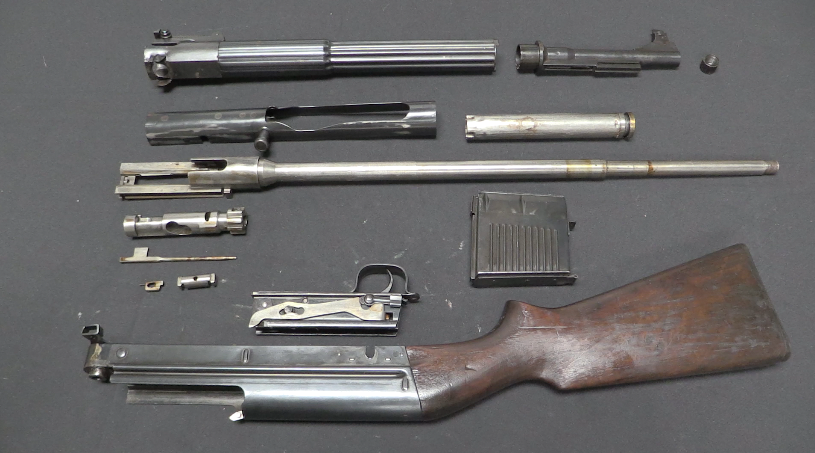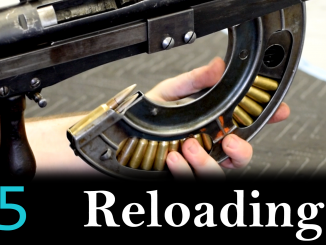Just a bit of shooting with an MP40 at an indoor range, courtesy of Hill & Mac Gunworks.
Related Articles

Reproduction
Reproduction Gerat 06 Rifles
For those of you who don’t regularly visit GunLab, Chuck posted an update there yesterday that’s worth checking out. He has spilled the beans about deciding to manufacture a small run of reproduction Gerat 06 […]

Prototype
RIA: Walther A115 Prototype Rifle
The Walther A115 was one of the semiauto rifles developed in pre-WWII Germany. Apparently only three were made, and it uses a neat combination of sheet metal construction with a rotating bolt and annular gas […]

Light MGs
Project Lightening Episode 05: Reload
Project Lightening is a collaborative series with Othais and Mae of C&Rsenal in which we test all seven light machine guns and automatic rifles of World War One and put them through a series of […]

Wow. Bucket List!
Wow! Karl got his beard and about 20 pounds or so back. Another Gun Jesus miracle!
I also happen to have some trigger time with MP 40 but the 115gr Sellier & Bellot factory ammo had noticeably longer intervals between the shots from what you have shown (worked flawlessly). What ammo did you guys used?
MP-40 was designed to use the fairly warm German Pistolenpatrone 08 123 grain (8 g) ammunition, which had a muzzle velocity of about 1250-1280 fps (380-390 m/s) with the 251 mm (9.9″) barrel of the MP-40. Since 1941 lighter 95 grain steel core bullets were used increasingly due to lead shortages, but the powder charge remained the same.
My understanding about the steel core 95-gr. ammunition has it that this was a very mild steel made of compressed sintered iron.
“sintered”
According to https://de.wikipedia.org/wiki/Sintern
Während des Zweiten Weltkrieges wurden die ursprünglich kupfernen Geschossführungsringe in Deutschland (wegen des Kupfermangels) durch Sintereisen („SiFe“) ersetzt.
Which mean: During second world war copper driving bands in Germany were replaced with Sintereisen (“SiFe”) one.
Yes, it was definitely not intended to be an armor piecing bullet, but simply a strategic material saving measure. The consumption of 9mm ammunition was very high once MP-40 production really took of and it appears that 9mm was almost always in short supply. Therefore the late war German attempts to make cheaper SMGs than the MP-40 (which was already reasonably cheap) were of dubious value, since they were not accompanied by increased ammunition production.
I had an opportunity to fire an MP-40 and agree, it is sweet, very controllable. I attribute it’s controllable rate of fire to it’s long bolt travel.
“MP-40 and agree, it is sweet, very controllable”
MP 38 must also seen modern if not futuristic when introduced in 1938, in times when most sub-machine guns have rifle-like wooden stocks.
However it must be noted that MP 38 don’t appear from nowhere but evolved from Erma EMP 35 sub-machine gun:
http://modernfirearms.net/smg/de/emp35-erma-e.html
“I attribute it’s controllable rate of fire to it’s long bolt travel.”
It is interesting to compare this weapon to French MAS-38 sub-machine gun which also have controllable recoil, if I am not mistaken, but rather on basis of (comparatively) weak cartridge ballistic-wise.
This one does indeed fire at a rate considerably faster than the one I used in the great way-back-when. But “then” was using US made relatively lower powered ammunition. Feed it German WW2 vintage rounds and it decidedly picked up the pace But in those days, WW2 was a lot more recent than now so reliability was not an issue.. And yes, very controllable, but I suspect having to do with being surprisingly heavy. Given the choice, I preferred the Sten as being somewhat lighter. Opinions vary, of course, but I’ll still suppose by the late 1960’s the truly crappy Sten and Sten mags, not to mention the equally crappy MP40’s were pretty much weeded out. In my experience both were pretty reliable. Heresy, I know, but there you have it.
“In my experience both were pretty reliable. Heresy, I know, but there you have it.”
As for all war-time production weapons quality vary. With which Mk (Mark) of STEN have you experience? http://modernfirearms.net/smg/brit/sten-e.html
It was a Mk II with the (desirable) louped stock. The “T” form with sling tended to catch on stuff when leaving a vehicle or a helicopter. Most annoying to watch your personal weapon leave you while it dangled from the skid of a Huey.
But to be fair, the mention of “Helicopter Friendly” was not prominent in the 1940 required specifications.
As Fins said “PPS, Suomi, PPSh, Beretta. Other are inferior”
I once read that Germans in Eastern Front, due to lack of proper winter grease for guns sometime used sunflower oil instead. Might it be true?
I doubt it, as “sunflower oil” is pretty much what the rest of the world calls “cooking oil” and is notorious for being not “lubricating” but rather “very-sticky-mess.” (Ask any KP.)
Aside from being unlikely to be much (anything titled “sunflower”) available in Stalingrad at that time, it’d be much better to run your MG42 (or anything else) dry than that crap.
Not good for a Panther tank, either. Unless, of course, you wish to fool the enemy by smelling like a French-fry on your approach. :):):)
Just sayin’
On the other hand, sunflowers are a big crop in Russia, and so sunflower oil would be there for the looting and taking…
Given the absolute dearth of petrochemicals, some weapons in the Spanish Civil War of 1936-1939 used–you guessed it–olive oil. George Orwell wrote in his _Homenaje_ that Spaniards in the Marxist POUM militia outfit he was with were astounded when he contrived a pull-through from boot laces to clean the bore of his 7mm rifle…”What’s that for?”
My understanding is that the French used gasoline as a solvent and motor oil as the lube and preservative. Certainly the U.S. Army M1 Garand manual suggests motor oil if nothing else is available.
Lamp oil grade inedible olive oil was the standard gun lubricant used by the Italian Royal Army in WW2. Petrochemicals were in very short supply in Italy, which did not have any local sources of crude oil. The Hungarians and Romanians sold their crude to Germany, which was able to pay more.
Olive oil works reasonably well in temperatures above freezing, but not that great below. I believe the Alpine troops must have used something else or run their weapons mostly dry. However, the Fiat-Revelli M.14 or M.35 will NOT run dry due to lack of primary extraction (and poorly designed fluted chamber in the case of the M.35.), so I it’s possible that the Alpine troops had access to mineral oils (they were considered elite).
As a chemist, I can comment that the problem with vegetable oils (of nearly any type) is that their chemistry tends towards breaking down into more water-friendly compounds, such as glycerol and fatty acids (sticky is a good word, and the water encourages corrosion), whereas petroleum based oils and greases tend to at least not get much worse from a “slickness” standpoint. Both types, of course, are vulnerable to being compromised by dirt and dust, but that is a separate issue.
Gasoline and motor oil would likely work well, in very small amounts. Cold weather combat might demand a bone dry gun for best functioning.
Oh, I don’t know… Some Aussies have convinced me of the virtues of the Owen’s design… Then again, like the KP31 Suomi, the thing is utterly heavy. To the degree that one would have to be fairly brawny or really tough to lug it around on an extended march.
1. Owen 9mm
2. PPS-43/KP44 “peltiheikki”
3. Beretta 38/42
4. Shpagin PPSh41
5. Suomi KP31
6. Sten Mk.II or Mk.III or Mk.V
7. MP40
8. Honorable mention: steyr-solothurn
9. MAS 38
10. M3
11. Thompson M1A1
“10. M3”
I assume that it means US sub-machine gun of World War II era.
Then why it manages to get to your best 11, but it improved version – M3A1 Grease Gun – don’t?
True… Make that the M3A1 “grease gun” with the clever magazine loader and finger slot instead of the sort of “crank” cocking lever that was prone to breakage…
What about the Hungarian Danuvia 43.M? Firing the powerful 9x25mm Mauser Export and with a long barrel it was probably the closest to a true “machine carbine” of any WW2 SMGs (since the US M2 carbine wasn’t really used in WW2).